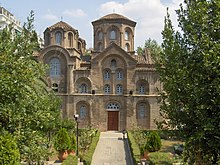User:Sarah fides/Architecture of Thessaloniki
| This user page or section is in a state of significant expansion or restructuring. You are welcome to assist in its construction by editing it as well. If this user page has not been edited in several days, please remove this template. If you are the editor who added this template and you are actively editing, please be sure to replace this template with {{in use}} during the active editing session. Click on the link for template parameters to use.
This page was last edited by CommonsDelinker (talk | contribs) 2 years ago. (Update timer) |

The Architecture of Thessaloniki spans a history of 2339 years from its foundation in 315 BC until the present day. The variety of its architecture is reflectant of its rich history and the various cultures that have ruled it. It is broadly categorised into the Hellenistic, Roman/Byzantine, Ottoman, early modern, and contemporary periods. Its Paleochristian and Byzantine architecture in particular is recognised in the city's 15 UNESCO World Heritage sites.
Although the city has evolved through the years, some aspects of it have remained constant. For example, the city's original Hippodamian grid from the 3rd century BC can be seen in the urban fabric of the city as late as 1917.[2] Much of the modern city is the result of the French architect Ernest Hébrard who redesigned the city along European trends following the Great Fire of 1917. The city continues to evolve in the present day, with regeneration projects as well as new additions, while projects such as the construction of the Thessaloniki Metro have brought to light more information about the city's architecture and history.
Historical background
[edit]
The city of Thessaloniki was founded in 315BC by Cassander, King of Macedon, who named it after his wife Thessalonike, half-sister of Alexander the Great. Cassander joined together the various settlements that existed in the region into a single polis, with its own parliament and laws. It quickly grew to become the commercial heart of Macedonia. Following the Macedonian Wars, it became part of the Roman Empire (then still a republic), and was made the capital of Roman Macedonia. Major investment projects happened at this time, including the rebuilding of the Roman Forum of Thessaloniki, or Thessalonica as it was known in Latin. Mark Antony made it a Free City in 41 BC. 100 years later, it had become an important centre of early Christianity; Paul the Apostle taught in the city's Etz Haim synagogue and the two letters that he wrote to the city's residents, First and Second Thessalonians, form part of the Biblical canon.
Under the Tetrarchy, Thessaloniki became one of the four capitals of the Roman Empire. The Roman Emperor Galerius built a monumental Palace complex as well as a Rotunda and Arch, which survive to this day. Later, with the decline of the Roman Empire, it was considered as a potential capital for the Eastern part of the Empire; Constantinople was eventually chosen, but Thessaloniki remained the second-most-important city. The first basilica of Hagios Demetrios and the Walls of Thessaloniki were built at this time. Constantine the Great also constructed an artificial harbour. Numerous churches, monasteries, baths, and other public buildings were created, many of which are now part of the Paleochristian and Byzantine monuments of Thessaloniki, a UNESCO World Heritage site. By the middle ages, the city had a populaton of 150,000; larger than London.
The Crusades played an important role in the decline of Thessaloniki. The sack of Constantinople by the armies of Western Europe in 1204 saw the collapse of the Byzantine Empire and the creation of the Kingdom of Thessalonica, later the Empire of Thessalonica. In the mid-14th century it was also briefly a Republic before returning to Byzantine imperial control. Various armies invaded the city, including the Goths, Slavs, and the Saracens, until the city became part of the Republic of Venice in 1423. It was later conquered by the Ottoman Empire in 1430, where it remained until 1912. The Ottomans built numerous mosques and turkish baths, as well as expanded the city's defences by building the White Tower, expanding the Heptapyrgion, and building other forts. From the mid-19th century onwards, part of the city walls was demolished and the Ottomans invested in major infrastructure and urban renewal projects.
Architectural periods
[edit]Hellenistic and early Roman
[edit]
Late antiquity
[edit]
Byzantine
[edit]
Ottoman
[edit]
Early modern
[edit]
After the fire
[edit]
Contemporary
[edit]Urbanism
[edit]Hébrard International Committee
[edit]
World Heritage sites
[edit]| UNESCO World Heritage Site | |
|---|---|
| Location | Historic centre of Thessaloniki |
| Includes | List of monuments
|
| Criteria | Cultural: (i), (ii), (iv) |
| Reference | 456-004 |
| Inscription | 1988 (12th Session) |
| Area | 5.327 ha (13.16 acres) |
Neighbourhoods
[edit]Frangomahalas
[edit]Ladadika
[edit]Upper Town
[edit]Vasilissis Olgas
[edit]See also
[edit]References
[edit]- ^ Purton, Peter Fraser (2009). A History of the Late Medieval Siege, 1200-1500. Boydell & Brewer. ISBN 9781843834496.
- ^ Vickers, Michael (1972). "Hellenistic Thessaloniki". The Journal of Hellenic Studies. 92: 156–170. doi:10.2307/629980.
